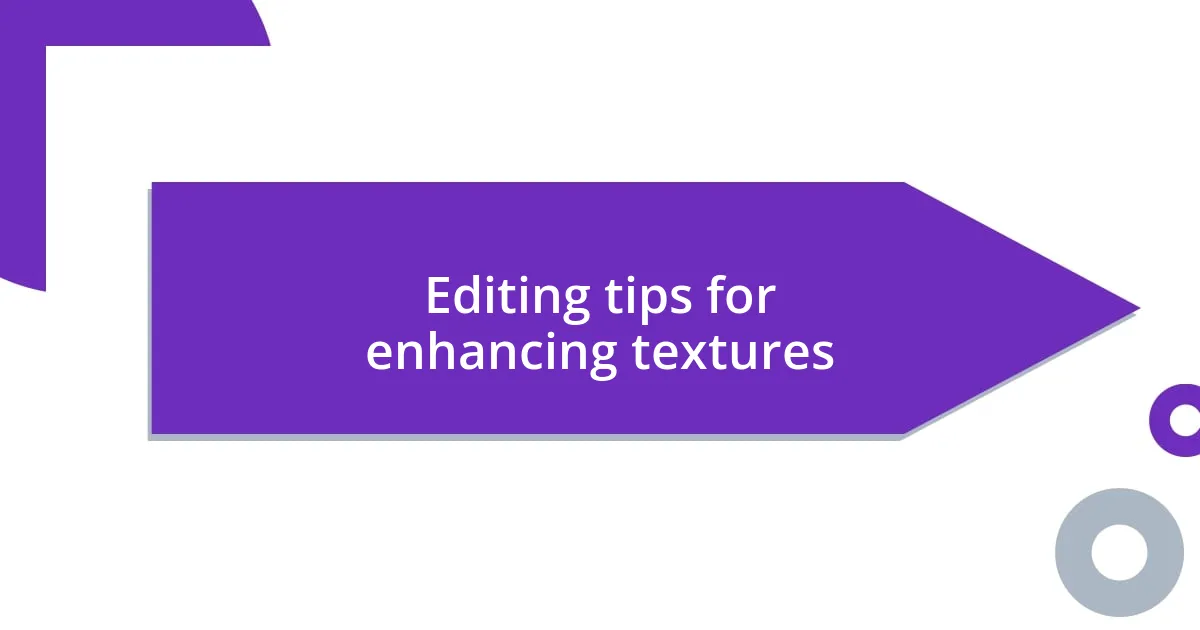Key takeaways:
- Macro textures enhance emotional connections and atmosphere, influencing our perception of spaces and objects.
- In photography, texture adds depth, engages viewers, and tells unique stories through visual contrast and composition.
- Techniques like using a macro lens, natural lighting, experimenting with angles, and applying shallow depth of field help capture textures effectively.
- Editing tools such as contrast, clarity, saturation, and sharpening can significantly enhance the vibrancy and emotional impact of macro textures.

Understanding macro textures
Macro textures are the intricacies of surfaces that often go unnoticed in everyday life, yet they hold profound importance in our perception and interaction with the world. I remember the first time I felt the rough bark of an ancient tree; it was as if I could sense its history and resilience through the coarse texture. Isn’t it fascinating how something as simple as a tactile experience can evoke such strong emotions and connections?
When I explore macro textures, I pay close attention to how they influence not just aesthetics, but also functionality. For instance, the plush cushion on my favorite chair offers both comfort and warmth, igniting a cozy feeling every time I sit down to read. How often do we stop to appreciate the soft or rugged surfaces that enhance our daily rituals?
Diving deeper, I’ve noticed that macro textures can vastly change the atmosphere of a space. A polished marble countertop can exude elegance, while a weathered wooden table conveys rustic charm. It’s intriguing to think that our surroundings can shape our moods and conversations simply through the textures we choose to live with. Have you ever considered how the textures in your home reflect your personality?

Importance of texture in photography
Texture in photography goes beyond mere visual appeal; it breathes life into images. For me, capturing the delicate veins of a leaf or the rugged surface of a stone transforms a simple photograph into an evocative experience. Each texture tells a story, drawing the viewer in and sparking a connection that might otherwise be missed.
- It enhances the emotional resonance of an image.
- Textures create depth, making photos more engaging.
- They can guide the viewer’s eye and set a particular mood.
- Different surfaces can elicit varied feelings and memories.
- Texture helps to emphasize contrasts, lighting, and composition in photography.
When I think about it, the way sunlight dances on a crinkled paper or the roughness of an old wall adds so much character to a photo. Each time I shoot, I try to find those hidden textures that not only catch the eye but stir the soul. It’s a beautiful reminder that there’s always more to discover in even the most ordinary subjects.

Techniques for capturing macro textures
When it comes to capturing macro textures, I often rely on my trusty macro lens. The magic happens when I’m just a few inches away from an intriguing surface, like the delicate patterns on a butterfly’s wing. I can’t emphasize enough how important lighting is. Natural light brings out the organic qualities of textures, creating shadows that enhance details, turning a mundane surface into a vibrant masterpiece.
Another technique I swear by involves experimentation with different angles. Whether it’s the coarse fibers of a frayed fabric or the intricate grooves of a seashell, moving around the subject allows me to discover surprising elements. I once spent an afternoon capturing the tiny bumps on an orange peel, and changing my perspective revealed hidden treasures I never expected. Have you ever played with angles while photographing? It can lead to unexpected, delightful results.
Lastly, using a shallow depth of field can draw attention to the texture itself. By blurring the background, I ensure that the viewer’s eye is directed towards the intricate details. I recall a moment when focusing tightly on the serrated edge of a leaf; the crispness of the foreground against a soft, dreamy backdrop made the texture pop. It’s these playful techniques that transform simple textures into intriguing stories.
| Technique | Description |
|---|---|
| Macro Lens | Allows for extreme close-ups, revealing intricate textures. |
| Natural Lighting | Illuminates surface details and creates depth through shadows. |
| Experimenting with Angles | Shifting perspectives reveals unexpected features in textures. |
| Shallow Depth of Field | Focuses attention on the subject by blurring the background. |

Composing macro texture images effectively
Composing macro texture images effectively requires a keen eye and a sense of intentionality. I often find myself subconsciously analyzing the composition, contemplating how the elements interact. For instance, placing a rough texture next to a smooth one creates visual tension that captivates the viewer. When I captured a photo of a smooth, wet pebble nestled among rough, jagged stones, it evoked feelings of serenity amid chaos. Can you feel that contrast, too?
I also believe in the power of the rule of thirds when framing macro textures. An off-center composition can breathe life into the image, making it feel more dynamic. I once experimented with this while photographing the intricate patterns on bark. By placing the textured surface slightly to the side, I not only drew attention to the detail but also allowed the surrounding elements, like the soft blur of foliage, to complement the main subject. Have you tried this technique? It might surprise you how it alters the viewer’s perception.
Finally, don’t underestimate the emotional weight of your color palette. The hues in a macro texture can influence the mood of your image significantly. While capturing the delicate frost patterns on a window, I noticed how the cool blues and whites evoked a sense of tranquility but also isolation. Contrast this with the warm, earthy tones I used for photos of worn, textured wood, which felt inviting and nostalgic. Have you noticed how colors affect the stories your images tell? It’s remarkable how subtle differences can amplify the emotional impact of your work.

Editing tips for enhancing textures
When editing macro textures, one of my favorite techniques is to adjust contrast and clarity. By subtly increasing these elements, I can make the textures stand out more vividly. I remember editing a close-up shot of colorful lichen on a rock—boosting clarity revealed the tiny, intricate details that I had almost missed in the original capture. Have you tried enhancing clarity in your edits? It can really bring your textures to life.
Another tip I often use involves working with saturation and vibrance. I find that these adjustments can drastically change the mood of a texture. For instance, while editing a photo of weathered wood, increasing the vibrance helped highlight the natural colors without making them look overly processed. It felt like I was breathing new life into the wood; have you ever experienced such transformation in your edits? There’s something incredibly satisfying about seeing those textures emerge more vividly.
Don’t overlook the power of sharpening your images! When I apply a bit of sharpening, I notice a remarkable difference in how textures pop, especially in subjects like crinkled paper or the delicate threads of fabric. In one instance, sharpening transformed an ordinary shot of an old, wrinkled letter into a stunning piece of art that told a story of age and wear. Have you had an aha moment with sharpening? It’s fascinating how a simple edit can evoke such strong emotions and responses in your viewers.

Showcasing macro textures in galleries
Showcasing macro textures in galleries is all about creating an immersive experience for the viewer. I’ve noticed that when I’ve displayed a series of images featuring a single texture, like the fine grooves of tree bark, it invites observers to linger longer and explore the details within each piece. Isn’t it fascinating how a simple, repeated theme can evoke curiosity and engagement?
In my experience, grouping macro textures by color or sensation enhances their impact. For instance, I once curated a display of close-ups of ocean waves and sand patterns, where the cool blues and warm tans resonated in harmony. The emotional pull of those swirling patterns captured the essence of the coastal experience. Can you imagine how such thoughtful arrangement can weave a story that transcends individual images?
Lighting plays a crucial role in how textures are perceived in gallery settings. During a recent exhibit, I experimented with backlighting on my macro images of leaf veins, and the results were breathtaking. The way light danced through the textures created a mesmerizing play of shadows and highlights. Have you considered how different lighting can transform the narrative in your own work? It truly breathes life into each texture, making the gallery experience memorable and enchanting.














